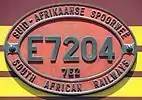South African Class 7E2, Series 2
The South African Railways Class 7E2, Series 2 of 1983 is an electric locomotive.
| South African Class 7E2, Series 2 | |||||||||||||||||||||||||||||||||||||||||||||||||||||||||||||
|---|---|---|---|---|---|---|---|---|---|---|---|---|---|---|---|---|---|---|---|---|---|---|---|---|---|---|---|---|---|---|---|---|---|---|---|---|---|---|---|---|---|---|---|---|---|---|---|---|---|---|---|---|---|---|---|---|---|---|---|---|---|
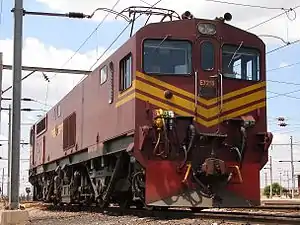 No. E7215 at Pyramid South, Pretoria, 6 October 2009 | |||||||||||||||||||||||||||||||||||||||||||||||||||||||||||||
| |||||||||||||||||||||||||||||||||||||||||||||||||||||||||||||
| |||||||||||||||||||||||||||||||||||||||||||||||||||||||||||||
| |||||||||||||||||||||||||||||||||||||||||||||||||||||||||||||
| |||||||||||||||||||||||||||||||||||||||||||||||||||||||||||||
In 1983, the South African Railways placed forty Class 7E2, Series 2 electric locomotives with a Co-Co wheel arrangement in mainline service.[1]
Manufacturer
.JPG.webp)
The 25 kV AC Class 7E2, Series 2 electric locomotive was designed for the South African Railways (SAR) by the 50 c/s Group, a consortium consisting of ACEC of Belgium, AEG-Telefunken and Siemens of Germany, Alsthom-Atlantique and Société MTE of France, and Brown Boveri of Switzerland.[2][3]
It was built by Union Carriage & Wagon (UCW) in Nigel, Transvaal, who delivered forty locomotives in 1983, numbered in the range from E7176 to E7215. UCW did not allocate builder's numbers to the locomotives it built for the SAR, but used the SAR unit numbers for their record keeping.[1]
Orientation
These dual cab locomotives have a roof access ladder on one side only, just to the right of the cab access door. The roof access ladder end is marked as the no. 2 end.[1]
In visual appearance, the Series 2 locomotives can be distinguished from the Series 1 by the vertical grilles just to the rear of the driver's window on both sides on the Series 2 locomotives, but absent on Series 1. Both series have a large grille to the right of centre on the side opposite the roof access ladder side, near roof level on Series 1 locomotives and low down near sill level on Series 2. The three grilles in line just to the rear of the side doors on Series 1 units were replaced with a single long grille on Series 2 units. Like the Class 7E, some of the Class 7E2, Series 2 locomotives have distinctive "eyebrow" rainwater beadings above their cab windscreens, but these were added post-delivery and were not installed on all the units.[1]
Characteristics
To reduce flange and rail wear, the bogies of both series of the Class 7E2 have a shorter wheelbase than the Class 7E, 4,060 millimetres (13 feet 3.8 inches) instead of 4,400 millimetres (14 feet 5.2 inches).[1][2]
As on the Class 7E, the locomotive's pantograph contact shoe centres are directly above the bogie pivot centres. The reason is to reduce the possibility of pantograph hookups on catenary in sharp curves, such as in turnouts, as a result of sideways movement of the pantograph in relation to the overhead wire.[1]
Service
The Class 7E2, Series 2 was placed in service on the northern 25 kV AC routes which stretch from Pyramid South north of Pretoria via Warmbad to Pietersburg and via Brits and Rustenburg to Thabazimbi. Most of them still serve here.[4]
Liveries
All the Class 7E2, Series 2 locomotives were delivered in the SAR red oxide livery with signal red buffer beams and cowcatchers, yellow whiskers and with the number plates on the sides mounted on three-stripe yellow wings. In the 1990s some of them were repainted in the Spoornet orange livery with a yellow and blue chevron pattern on the buffer beams and cowcatchers. Some later received the Spoornet maroon livery. In the late 1990s most were repainted in the Spoornet blue livery with outline numbers on the long hood sides. After 2008 in the Transnet Freight Rail (TFR) and Passenger Rail Agency of South Africa (PRASA) era, some were repainted in the TFR red, green and yellow livery and at least one was repainted in the Shosholoza Meyl purple livery.[5]
Illustration
 No. E7202 in Spoornet orange livery at Pyramid South, 6 October 2009
No. E7202 in Spoornet orange livery at Pyramid South, 6 October 2009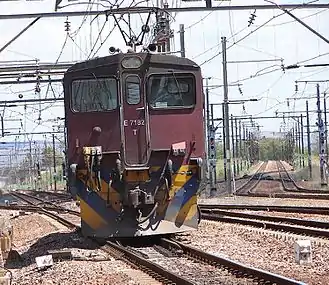 No. E7182 in Spoornet maroon at Pyramid North, 6 October 2009
No. E7182 in Spoornet maroon at Pyramid North, 6 October 2009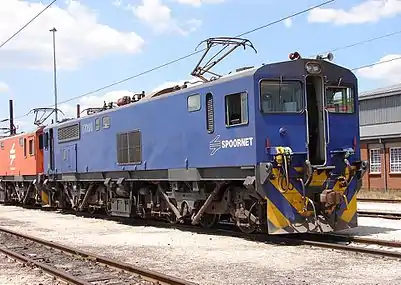 No. E7200 in Spoornet blue with outline numbers at Pyramid South, 6 October 2009
No. E7200 in Spoornet blue with outline numbers at Pyramid South, 6 October 2009
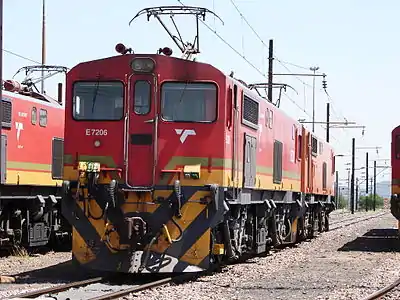 No. E7206 in Transnet Freight Rail livery at Pyramid South, 27 September 2015
No. E7206 in Transnet Freight Rail livery at Pyramid South, 27 September 2015 No. E7201 in PRASA's Shosholoza Meyl livery at Pyramid South, 7 May 2013
No. E7201 in PRASA's Shosholoza Meyl livery at Pyramid South, 7 May 2013
References
| Wikimedia Commons has media related to South African Class 7E2, Series 2. |
- South African Railways Index and Diagrams Electric and Diesel Locomotives, 610mm and 1065mm Gauges, Ref LXD 14/1/100/20, 28 January 1975, as amended
- Paxton, Leith; Bourne, David (1985). Locomotives of the South African Railways (1st ed.). Cape Town: Struik. pp. 129–131. ISBN 0869772112.
- "UCW - Electric locomotives" (PDF). The UCW Partnership. Archived from the original (PDF) on 12 October 2007. Retrieved 30 September 2010.
- Middleton, John N. (2002). Railways of Southern Africa Locomotive Guide - 2002 (as amended by Combined Amendment List 4, January 2009) (2nd, Dec 2002 ed.). Herts, England: Beyer-Garratt Publications. pp. 50–51, 61xx–yy.
- Soul of A Railway, System 7, Western Transvaal, based in Johannesburg, Part 9. South-Eastwards as far as Volksrust (2nd part) by Les Pivnic. Caption 4. (Accessed on 11 April 2017)
